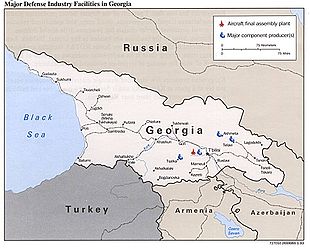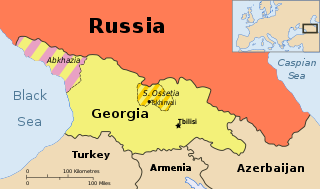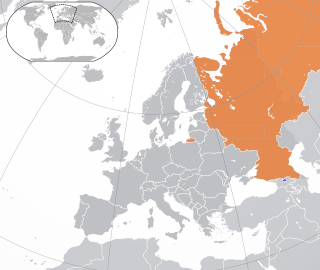
Some Infrastructure damage during the Russo-Georgian War took place.

Some Infrastructure damage during the Russo-Georgian War took place.
According to Human Rights Watch (HRW):
"[o]n the night of August 7-8, Georgian forces subjected the city of Tskhinvali and several nearby Ossetian villages, including Nizhnii Gudjabauri and Khetagurovo, to heavy shelling. [...] Tskhinvali was heavily shelled during daytime hours on August 8. [...] Shelling resumed at a smaller scale on August 9, when Georgian forces were targeting Russian troops who by then had moved into Tskhinvali and other areas of South Ossetia."
HRW reported that South Ossetian fighters took up positions in civilian objects (including schools), making them permissible military aims. Several of these objects were then targeted by Georgian artillery. [1]
On 12 August 2008, local authorities claimed that about 70 percent of Tskhinvali's buildings (public and private) had been damaged during the Georgian military operation. [2] According to later Russian statement, about 20 percent of Tskhinvali's buildings had been damaged and 10 percent were "beyond repair". [3] In late August, South Ossetian parliament deputy speaker Tarzan Kokoity claimed that according to a preliminary assessment, Georgian damage in South Ossetia was valued at 100 billion Russian rubles. [4]
The Georgian government reported that Tskhinvali "was largely reduced to rubble" as a result of Russian air attacks. [5] "When aircraft started bombing our positions in Tskhinvali, this is when most civilian buildings were burned", explained Davit Kezerashvili. [6] Russian journalist Yulia Latynina also blamed Russia for damaging the city, saying that when Georgian forces entered Tskhinvali it was intact. After they were driven out by the Russians, the city was in ruins. [7]
Russia bombed airfields and other economic infrastructure. The Black Sea port of Poti was also bombed, where eight to eleven Russian warplanes reportedly attacked container tanks and a shipbuilding plant. [8] On 15 August 2008, Russian forces advancing towards Tbilisi blew up the railway bridge near Kaspi, about 50 km (31 mi) from the Georgian capital. The cement factory and civilian area in Kaspi were also damaged by Russian bombing. [9] The destruction of the railway bridge sabotaged the east-west link of Georgia and Armenia's main trade route. [10]
Nikolay Bordyuzha, Secretary-General of the Collective Security Treaty Organization, stated that Armenia lost $500 million due to problems with the communications during the war. [11]
The United Nations Institute for Training and Research (UNITAR) released a series of detailed satellite maps of the regions affected by the war, obtained on 19 August from UNOSAT. [12] Damage was assessed primarily from satellite images with a resolution of 50 cm. Since it was an initial assessment, it was not independently validated on the ground. UNOSAT reported that 230 buildings in Tskhinvali (5.5 percent of the total) were destroyed or severely damaged. In the villages north of the city, up to 51.9 percent of buildings were damaged. [13] UNOSAT provided imagery of six Georgian naval vessels partially or completely submerged in Poti; no other damage to physical infrastructure or ship-related oil spills were revealed. [14]
Human Rights Watch used the UNOSAT satellite images to prove the rampant arson of ethnic-Georgian villages by Ossetian militia in South Ossetia. [15] Amnesty International noted that the Russo-Georgian battle in Tskhinvali during the war had possibly resulted in the destruction of the most of the city by the end of large-scale conflict by 10 August; however, after the war Georgian villages near Tskhinvali were damaged. [16]

South Ossetia, officially the Republic of South Ossetia or the State of Alania, is a partially recognised landlocked state in the South Caucasus. It has an officially stated population of just over 56,500 people (2022), who live in an area of 3,900 square kilometres (1,500 sq mi), with 33,000 living in the capital city, Tskhinvali.

Tskhinvali or Tskhinval is the capital of the disputed de facto independent Republic of South Ossetia, internationally considered part of Shida Kartli, Georgia .Tskhinvali Region, known historically as Samachablo, was always part of the Georgian state as a single military and administrative entity. It is located on the Great Liakhvi River approximately 100 kilometres (62 mi) northwest of the Georgian capital Tbilisi.

The Georgian–Ossetian conflict is an ethno-political conflict over Georgia's former autonomous region of South Ossetia, which evolved in 1989 and developed into a war. Despite a declared ceasefire and numerous peace efforts, the conflict remained unresolved. In August 2008, military tensions and clashes between Georgia and South Ossetian separatists erupted into the Russo-Georgian War. Since then, South Ossetia has been under Russian occupation.

The 1991–1992 South Ossetia War was fought between Georgian government forces and ethnic Georgian militias on one side and the forces of South Ossetian separatists and Russia on the other. The war ended with a Dagomys Agreement, signed on 24 June 1992, which established a joint peacekeeping force and left South Ossetia divided between the rival authorities.
Joint Control Commission for Georgian–Ossetian Conflict Resolution (JCC) was a peacekeeping organization, operating in South Ossetia and overseeing the joint peacekeeping forces in the region. It was disbanded on October 10, 2008.
An international diplomatic crisis between Georgia and Russia began in 2008, when Russia announced that it would no longer participate in the Commonwealth of Independent States economic sanctions imposed on Abkhazia in 1996 and established direct relations with the separatist authorities in Abkhazia and South Ossetia. The crisis was linked to the push for Georgia to receive a NATO Membership Action Plan and, indirectly, the unilateral declaration of independence by Kosovo.

The 2008 Russo-Georgian War was a war between Russia, alongside the Russian-backed self-proclaimed republics of South Ossetia and Abkhazia, and Georgia. The war took place in August following a diplomatic crisis between Russia and Georgia, both formerly constituent republics of the Soviet Union. The fighting took place in the strategically important South Caucasus region. It is regarded as the first European war of the 21st century.

The Battle of Tskhinvali was the battle for the city of Tskhinvali, capital of the breakaway state of South Ossetia. It was the only major battle during the entirety of the Russo-Georgian War. Georgian ground troops entered the city on early 8 August 2008, after an artillery assault. Georgians took control of most of the city in hours. Russian main forces began entering South Ossetia through the Roki tunnel. After being initially forced to withdraw, the Georgian troops made several attempts to retake the city. Due to the difficult logistics of the terrain, the arrival of Russian reinforcements was slow. After fierce fighting, Georgian troops were finally forced to withdraw from the city on the evening of 10 August. On 11 August, all Georgian troops left South Ossetia. Parts of Tskhinvali were devastated in the three-day fighting.

The Russo-Georgian War broke out in August 2008 and involved Georgia, Russian Federation, South Ossetia and Abkhazia.
Khetagurovo is a 150-house village in South Ossetia, de facto independent partially recognized republic in the South Caucasus, formerly the South Ossetian Autonomous Oblast within the Georgian Soviet Socialist Republic. The village has been controlled by the South Ossetian forces since the armed clashes with the Georgian troops in 1991/1992. Until 1991 village was part of Tskhinvali district, Gori municipality. Sakrebulo center.

The Russo-Georgian War included an extensive information war.

Russia–South Ossetia relations refers to the bilateral relationship between Russia and the Republic of South Ossetia, a disputed region in the South Caucasus, located on the territory of the South Ossetian Autonomous Oblast within the former Georgian Soviet Socialist Republic.

The Armed Forces of South Ossetia is the military of the partially recognised state of South Ossetia. It includes an Army and an Air Corps.

The Russo-Georgian War had a huge humanitarian impact on the lives of civilians. In the aftermath of the war, ethnic Georgians were expelled from South Ossetia and most of the Georgian villages were razed.

The Russo-Georgian War caused major infrastructural and economic damage throughout Georgian and South Ossetian territory. Many countries promised reconstruction aid to the affected regions.

Both sides of the 2008 war between Russia and Georgia blamed each other for starting the war.

Ethnic cleansing of Georgians in South Ossetia was a mass expulsion of ethnic Georgians conducted in South Ossetia and other territories occupied by Russian and South Ossetian forces, which happened during and after the 2008 Russia–Georgia war. Overall, at least 20,000 Georgians were forcibly displaced from South Ossetia.
Tamarasheni is a former village in Georgia, within the territory controlled by separatist South Ossetia, some 0.5 km north of Tskhinvali.
South Ossetia is a partially recognised landlocked state, approximately 1,000 metres (3,300 ft) above sea level on the slopes of the Greater Caucasus. Although it declared independence in 2008, only a few countries acknowledge it. The region is inhabited by Ossetians, an Iranian ethnic group. According to Russia, Nicaragua, Venezuela, Syria and Nauru, it is one of the world's newest independent states. All other states and international organisations consider South Ossetia an autonomous region of Georgia, functioning as a de facto state for twenty years after declaring independence and conducting a successful armed rebellion. Its Georgian inhabitants have been displaced. South Ossetia has been a source of tension for a number of years, with Georgia and Russia's political differences impeding peaceful independence and breeding a turbulent series of events which undermine the Universal Declaration of Human Rights.

The Tiri monastery is a 13th-century church near Tskhinvali in what is now the disputed territory of South Ossetia. Built as a Georgian Orthodox monastery in a hall church plan, it bears medieval frescoes and Georgian inscriptions. After the 2008 Russo-Georgian War, the Georgians lost access to the monastery. In 2015, the church building was subjected to maintenance works which infringed on authenticity and partially damaged the frescoes, leading to a controversy in Tskhinvali and protests from Georgia. The monastery is inscribed on the list of Georgia's Immovable Cultural Monuments of National Significance.